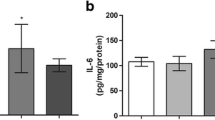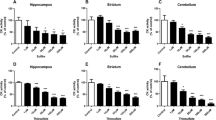Abstract
S-Adenosylmethionine (AdoMet) concentrations are highly elevated in tissues and biological fluids of patients affected by S-adenosylhomocysteine hydrolase deficiency. This disorder is clinically characterized by severe neurological symptoms, whose pathophysiology is not yet established. Therefore, we investigated the effects of intracerebroventricular administration of AdoMet on redox homeostasis, microglia activation, synaptophysin levels, and TAU phosphorylation in cerebral cortex and striatum of young rats. AdoMet provoked significant lipid and protein oxidation, decreased glutathione concentrations, and altered the activity of important antioxidant enzymes in cerebral cortex and striatum. AdoMet also increased reactive oxygen (2′,7′-dichlorofluorescein oxidation increase) and nitrogen (nitrate and nitrite levels increase) species generation in cerebral cortex. Furthermore, the antioxidants N-acetylcysteine and melatonin prevented most of AdoMet-induced pro-oxidant effects in both cerebral structures. Finally, we verified that AdoMet produced microglia activation by increasing Iba1 staining and TAU phosphorylation, as well as reduced synaptophysin levels in cerebral cortex. Taken together, it is presumed that impairment of redox homeostasis possibly associated with microglia activation and neuronal dysfunction caused by AdoMet may represent deleterious pathomechanisms involved in the pathophysiology of brain damage in S-adenosylhomocysteine hydrolase deficiency.










Similar content being viewed by others
References
Gaull GE, Von Berg W, Raiha NC, Sturman JA (1973) Development of methyltransferase activities of human fetal tissues. Pediatr Res 7(5):527–533. https://doi.org/10.1203/00006450-197305000-00006
Grubbs R, Vugrek O, Deisch J, Wagner C, Stabler S, Allen R, Baric I, Rados M et al (2010) S-adenosylhomocysteine hydrolase deficiency: two siblings with fetal hydrops and fatal outcomes. J Inherit Metab Dis 33(6):705–713. https://doi.org/10.1007/s10545-010-9171-x
Honzik T, Magner M, Krijt J, Sokolova J, Vugrek O, Beluzic R, Baric I, Hansikova H et al (2012) Clinical picture of S-adenosylhomocysteine hydrolase deficiency resembles phosphomannomutase 2 deficiency. Mol Genet Metab 107(3):611–613. https://doi.org/10.1016/j.ymgme.2012.08.014
Mudd SH, Brosnan JT, Brosnan ME, Jacobs RL, Stabler SP, Allen RH, Vance DE, Wagner C (2007) Methyl balance and transmethylation fluxes in humans. Am J Clin Nutr 85(1):19–25. https://doi.org/10.1093/ajcn/85.1.19
Stender S, Chakrabarti RS, Xing C, Gotway G, Cohen JC, Hobbs HH (2015) Adult-onset liver disease and hepatocellular carcinoma in S-adenosylhomocysteine hydrolase deficiency. Mol Genet Metab 116(4):269–274. https://doi.org/10.1016/j.ymgme.2015.10.009
Strauss KA, Ferreira C, Bottiglieri T, Zhao X, Arning E, Zhang S, Zeisel SH, Escolar ML et al (2015) Liver transplantation for treatment of severe S-adenosylhomocysteine hydrolase deficiency. Mol Genet Metab 116(1–2):44–52. https://doi.org/10.1016/j.ymgme.2015.06.005
Baric I, Staufner C, Augoustides-Savvopoulou P, Chien YH, Dobbelaere D, Grunert SC, Opladen T, Petkovic Ramadza D et al (2017) Consensus recommendations for the diagnosis, treatment and follow-up of inherited methylation disorders. J Inherit Metab Dis 40(1):5–20. https://doi.org/10.1007/s10545-016-9972-7
Baric I, Fumic K, Glenn B, Cuk M, Schulze A, Finkelstein JD, James SJ, Mejaski-Bosnjak V et al (2004) S-adenosylhomocysteine hydrolase deficiency in a human: a genetic disorder of methionine metabolism. Proc Natl Acad Sci U S A 101(12):4234–4239. https://doi.org/10.1073/pnas.0400658101
Baric I, Cuk M, Fumic K, Vugrek O, Allen RH, Glenn B, Maradin M, Pazanin L et al (2005) S-Adenosylhomocysteine hydrolase deficiency: a second patient, the younger brother of the index patient, and outcomes during therapy. J Inherit Metab Dis 28(6):885–902. https://doi.org/10.1007/s10545-005-0192-9
Finkelstein JD, Kyle W, Harris BJ (1971) Methionine metabolism in mammals. Regulation of homocysteine methyltransferases in rat tissue. Arch Biochem Biophys 146(1):84–92
Gao J, Cahill CM, Huang X, Roffman JL, Lamon-Fava S, Fava M, Mischoulon D, Rogers JT (2018) S-Adenosyl methionine and transmethylation pathways in neuropsychiatric diseases throughout life. Neurotherapeutics 15(1):156–175. https://doi.org/10.1007/s13311-017-0593-0
Rubin RA, Ordonez LA, Wurtman RJ (1974) Physiological dependence of brain methionine and S-adenosylmethionine concentrations on serum amino acid pattern. J Neurochem 23(1):227–231
Molloy AM, Orsi B, Kennedy DG, Kennedy S, Weir DG, Scott JM (1992) The relationship between the activity of methionine synthase and the ratio of S-adenosylmethionine to S-adenosylhomocysteine in the brain and other tissues of the pig. Biochem Pharmacol 44(7):1349–1355
Halliwell BGJ (2015) Cellular responses to oxidative stress: adaptation, damage, repair, senescence and death. In: Free radicals in biology and medicine. Oxford University Press Inc, Oxford, pp. 199–283
Zanatta A, Cecatto C, Ribeiro RT, Amaral AU, Wyse AT, Leipnitz G, Wajner M (2017) S-Adenosylmethionine promotes oxidative stress and decreases Na(+), K(+)-ATPase activity in cerebral cortex supernatants of adolescent rats: implications for the pathogenesis of S-adenosylhomocysteine hydrolase deficiency. Mol Neurobiol 55:5868–5878. https://doi.org/10.1007/s12035-017-0804-z
Paxinos G, Watson C (2013) The rat brain in stereotaxic coordinates, 7th edn. Academic, Cambridge
da Rosa MS, Joao Ribeiro CA, Seminotti B, Teixeira Ribeiro R, Amaral AU, Coelho Dde M, de Oliveira FH, Leipnitz G et al (2015) In vivo intracerebral administration of L-2-hydroxyglutaric acid provokes oxidative stress and histopathological alterations in striatum and cerebellum of adolescent rats. Free Radic Biol Med 83:201–213. https://doi.org/10.1016/j.freeradbiomed.2015.02.008
Evelson P, Travacio M, Repetto M, Escobar J, Llesuy S, Lissi EA (2001) Evaluation of total reactive antioxidant potential (TRAP) of tissue homogenates and their cytosols. Arch Biochem Biophys 388(2):261–266. https://doi.org/10.1006/abbi.2001.2292
Lowry OH, Rosebrough NJ, Farr AL, Randall RJ (1951) Protein measurement with the Folin phenol reagent. J Biol Chem 193(1):265–275
Yagi K (1998) Simple procedure for specific assay of lipid hydroperoxides in serum or plasma. Methods Mol Biol 108:107–110. https://doi.org/10.1385/0-89603-472-0:107
Reznick AZ, Packer L (1994) Oxidative damage to proteins: spectrophotometric method for carbonyl assay. Methods Enzymol 233:357–363
Aksenov MY, Markesbery WR (2001) Changes in thiol content and expression of glutathione redox system genes in the hippocampus and cerebellum in Alzheimer’s disease. Neurosci Lett 302(2–3):141–145
Browne RW, Armstrong D (1998) Reduced glutathione and glutathione disulfide. Methods Mol Biol 108:347–352. https://doi.org/10.1385/0-89603-472-0:347
Teare JP, Punchard NA, Powell JJ, Lumb PJ, Mitchell WD, Thompson RP (1993) Automated spectrophotometric method for determining oxidized and reduced glutathione in liver. Clin Chem 39(4):686–689
Wendel A (1981) Glutathione peroxidase. Methods Enzymol 77:325–333
Carlberg I, Mannervik B (1985) Glutathione reductase. Methods Enzymol 113:484–490
Marklund SL (1985) Product of extracellular-superoxide dismutase catalysis. FEBS Lett 184(2):237–239
Aebi H (1984) Catalase in vitro. Methods Enzymol 105:121–126
Guthenberg C, Mannervik B (1981) Glutathione S-transferase (transferase pi) from human placenta is identical or closely related to glutathione S-transferase (transferase rho) from erythrocytes. Biochim Biophys Acta 661(2):255–260
Leong SF, Clark JB (1984) Regional development of glutamate dehydrogenase in the rat brain. J Neurochem 43(1):106–111
LeBel CP, Ischiropoulos H, Bondy SC (1992) Evaluation of the probe 2′,7′-dichlorofluorescin as an indicator of reactive oxygen species formation and oxidative stress. Chem Res Toxicol 5(2):227–231
Navarro-Gonzalvez JA, Garcia-Benayas C, Arenas J (1998) Semiautomated measurement of nitrate in biological fluids. Clin Chem 44(3):679–681
Moura AP, Parmeggiani B, Gasparotto J, Grings M, Fernandez Cardoso GM, Seminotti B, Moreira JCF, Gelain DP et al (2018) Glycine administration alters MAPK signaling pathways and causes neuronal damage in rat brain: putative mechanisms involved in the neurological dysfunction in nonketotic hyperglycinemia. Mol Neurobiol 55(1):741–750. https://doi.org/10.1007/s12035-016-0319-z
Waza AA, Hamid Z, Ali S, Bhat SA, Bhat MA (2018) A review on heme oxygenase-1 induction: is it a necessary evil. Inflamm Res 67:579–588. https://doi.org/10.1007/s00011-018-1151-x
Hoogland IC, Houbolt C, van Westerloo DJ, van Gool WA, van de Beek D (2015) Systemic inflammation and microglial activation: systematic review of animal experiments. J Neuroinflammation 12:114. https://doi.org/10.1186/s12974-015-0332-6
Dalle-Donne I, Rossi R, Giustarini D, Milzani A, Colombo R (2003) Protein carbonyl groups as biomarkers of oxidative stress. Clin Chim Acta 329(1–2):23–38
Davies MJ (2003) Singlet oxygen-mediated damage to proteins and its consequences. Biochem Biophys Res Commun 305(3):761–770
Reiter RJ, Tan DX, Manchester LC, Qi W (2001) Biochemical reactivity of melatonin with reactive oxygen and nitrogen species: a review of the evidence. Cell Biochem Biophys 34(2):237–256. https://doi.org/10.1385/CBB:34:2:237
Anisimov VN (2006) Premature ageing prevention: limitations and perspectives of pharmacological interventions. Curr Drug Targets 7(11):1485–1503
Elbini Dhouib I, Jallouli M, Annabi A, Gharbi N, Elfazaa S, Lasram MM (2016) A minireview on N-acetylcysteine: an old drug with new approaches. Life Sci 151:359–363. https://doi.org/10.1016/j.lfs.2016.03.003
Singh P, Jain A, Kaur G (2004) Impact of hypoglycemia and diabetes on CNS: correlation of mitochondrial oxidative stress with DNA damage. Mol Cell Biochem 260(1–2):153–159
Kaushik S, Kaur J (2003) Chronic cold exposure affects the antioxidant defense system in various rat tissues. Clin Chim Acta 333(1):69–77
Jafari M (2007) Dose- and time-dependent effects of sulfur mustard on antioxidant system in liver and brain of rat. Toxicology 231(1):30–39. https://doi.org/10.1016/j.tox.2006.11.048
Myhre O, Andersen JM, Aarnes H, Fonnum F (2003) Evaluation of the probes 2′,7′-dichlorofluorescin diacetate, luminol, and lucigenin as indicators of reactive species formation. Biochem Pharmacol 65(10):1575–1582
Bonini MG, Rota C, Tomasi A, Mason RP (2006) The oxidation of 2′,7′-dichlorofluorescin to reactive oxygen species: a self-fulfilling prophesy? Free Radic Biol Med 40(6):968–975. https://doi.org/10.1016/j.freeradbiomed.2005.10.042
Ito D, Imai Y, Ohsawa K, Nakajima K, Fukuuchi Y, Kohsaka S (1998) Microglia-specific localisation of a novel calcium binding protein, Iba1. Brain Res Mol Brain Res 57(1):1–9
Serrano-Pozo A, Gomez-Isla T, Growdon JH, Frosch MP, Hyman BT (2013) A phenotypic change but not proliferation underlies glial responses in Alzheimer disease. Am J Pathol 182(6):2332–2344. https://doi.org/10.1016/j.ajpath.2013.02.031
Wirths O, Breyhan H, Marcello A, Cotel MC, Bruck W, Bayer TA (2010) Inflammatory changes are tightly associated with neurodegeneration in the brain and spinal cord of the APP/PS1KI mouse model of Alzheimer’s disease. Neurobiol Aging 31(5):747–757. https://doi.org/10.1016/j.neurobiolaging.2008.06.011
Norden DM, Trojanowski PJ, Villanueva E, Navarro E, Godbout JP (2016) Sequential activation of microglia and astrocyte cytokine expression precedes increased Iba-1 or GFAP immunoreactivity following systemic immune challenge. Glia 64(2):300–316. https://doi.org/10.1002/glia.22930
Balducci C, Forloni G (2018) Novel targets in Alzheimer’s disease: a special focus on microglia. Pharmacol Res 130:402–413. https://doi.org/10.1016/j.phrs.2018.01.017
Sun L, Shen R, Agnihotri SK, Chen Y, Huang Z, Bueler H (2018) Lack of PINK1 alters glia innate immune responses and enhances inflammation-induced, nitric oxide-mediated neuron death. Sci Rep 8(1):383. https://doi.org/10.1038/s41598-017-18786-w
Gudi V, Gai L, Herder V, Tejedor LS, Kipp M, Amor S, Suhs KW, Hansmann F et al (2017) Synaptophysin is a reliable marker for axonal damage. J Neuropathol Exp Neurol 76:109–125. https://doi.org/10.1093/jnen/nlw114
Wang X, Cheng JL, Ran YC, Zhang Y, Yang L, Lin YN (2017) Expression of RGMb in brain tissue of MCAO rats and its relationship with axonal regeneration. J Neurol Sci 383:79–86. https://doi.org/10.1016/j.jns.2017.10.032
Thome J, Pesold B, Baader M, Hu M, Gewirtz JC, Duman RS, Henn FA (2001) Stress differentially regulates synaptophysin and synaptotagmin expression in hippocampus. Biol Psychiatry 50(10):809–812
Xu H, He J, Richardson JS, Li XM (2004) The response of synaptophysin and microtubule-associated protein 1 to restraint stress in rat hippocampus and its modulation by venlafaxine. J Neurochem 91(6):1380–1388. https://doi.org/10.1111/j.1471-4159.2004.02827.x
Terry RD (1998) The cytoskeleton in Alzheimer disease. J Neural Transm Suppl 53:141–145
Kuszczyk M, Gordon-Krajcer W, Lazarewicz JW (2009) Homocysteine-induced acute excitotoxicity in cerebellar granule cells in vitro is accompanied by PP2A-mediated dephosphorylation of tau. Neurochem Int 55(1–3):174–180. https://doi.org/10.1016/j.neuint.2009.02.010
Abisambra JF, Jinwal UK, Blair LJ, O'Leary JC 3rd, Li Q, Brady S, Wang L, Guidi CE et al (2013) Tau accumulation activates the unfolded protein response by impairing endoplasmic reticulum-associated degradation. J Neurosci 33(22):9498–9507. https://doi.org/10.1523/JNEUROSCI.5397-12.2013
Lee VM, Goedert M, Trojanowski JQ (2001) Neurodegenerative tauopathies. Annu Rev Neurosci 24:1121–1159. https://doi.org/10.1146/annurev.neuro.24.1.1121
Funding
This work was supported by the Conselho Nacional de Desenvolvimento Científico e Tecnológico [grant number #404883/2013-3], Fundação de Amparo à Pesquisa do Estado do Rio Grande do Sul [grant number #2266- 2551/14-2], and Financiadora de Estudos e Projetos/Rede Instituto Brasileiro de Neurociência [grant number #01.06.0842-00].
Author information
Authors and Affiliations
Corresponding author
Ethics declarations
The experimental protocol was approved by the local Animal Ethics Committe of Universidade Federal do Rio Grande do Sul. The guidelines of National Institutes of Health Guide for the Care and Use of Laboratory Animals (NIH publication no. 80–23, revised 2011) and Directive 2010/63/EU were followed.
Conflict of Interest
The authors declare that they have no conflicts of interest.
Rights and permissions
About this article
Cite this article
Seminotti, B., Zanatta, Â., Ribeiro, R.T. et al. Disruption of Brain Redox Homeostasis, Microglia Activation and Neuronal Damage Induced by Intracerebroventricular Administration of S-Adenosylmethionine to Developing Rats. Mol Neurobiol 56, 2760–2773 (2019). https://doi.org/10.1007/s12035-018-1275-6
Received:
Accepted:
Published:
Issue Date:
DOI: https://doi.org/10.1007/s12035-018-1275-6




